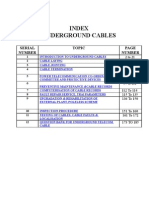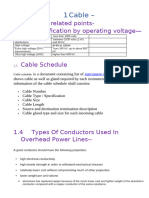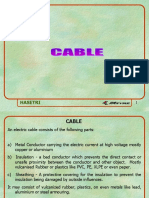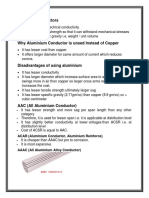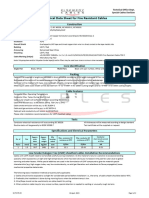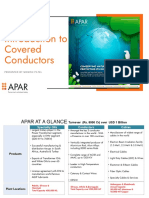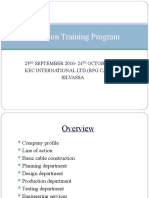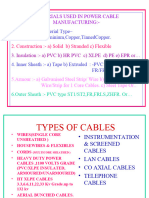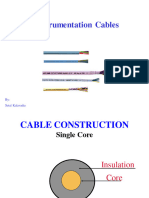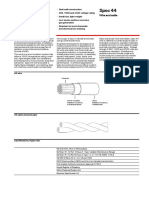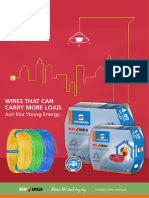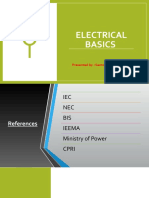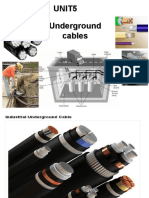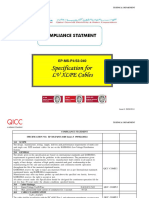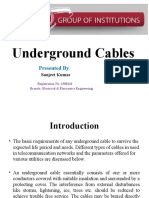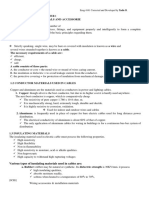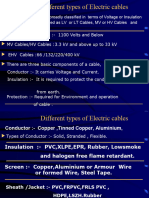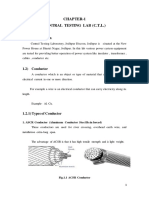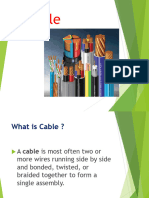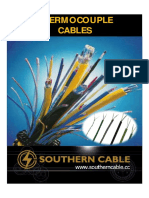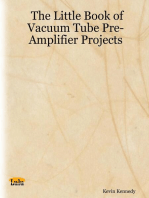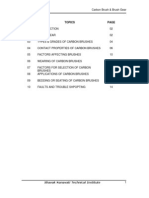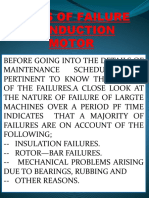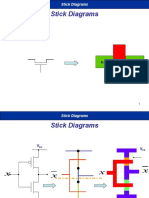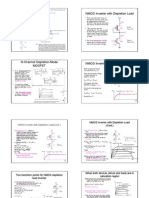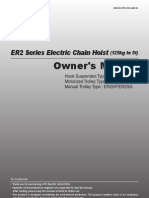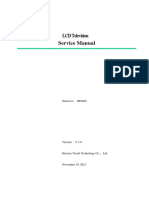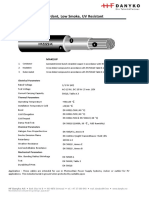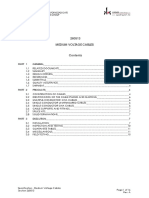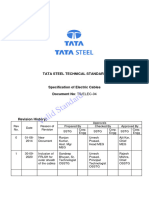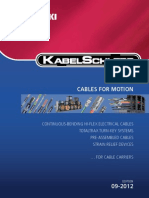Cable and Insulators
Cable and Insulators
Uploaded by
Varun KumarCopyright:
Available Formats
Cable and Insulators
Cable and Insulators
Uploaded by
Varun KumarCopyright
Available Formats
Share this document
Did you find this document useful?
Is this content inappropriate?
Copyright:
Available Formats
Cable and Insulators
Cable and Insulators
Uploaded by
Varun KumarCopyright:
Available Formats
Cable and Insulator
CABLES
MERIT AND DEMERIT OF CABLE
1. It has good impact on over all power system effectiveness and
continuity of power guarantee.
2. More reliable
3. More cost per Kw per km
4. Tapping is difficult
5. Less liability to damage due to natural calamity
6. Difficult and Expensive joint
7. Requires Small apace
8. Low reactance
9. Better regulation
10. Sharp bending possible
11. Long life
12. High over load capacity
13. Access for repairing
14. High short circuit rating
15. Good vibration resistance
16. Water and weather proof
17. good corrosion resistance
18. High safety against hazards
19. Good esthetics
20. Can be used in power, control telecom.
21. High cost
22. Fault finding difficult
Shavak Nanavati Technical Institute
Cable and Insulator
ADVANTAGES OF ALUMINIUM CONDUCTOR
1. Cheaper in cost
2. Lighter in weight
3. Poor conductivity
4. Low tensile strength
5. Larger cross sectional area required for same current.
6. Linear coefficient of expansion is 1.4 time more than copper
7. Low melting point
8. Easily affected by corrosion
9. Jointing difficult.
ADVANTAGE OF COPPER CONDUCTOR
1. High conductivity
2. High tensile strength
3. High corrosion resistance at normal atmosphere
4. Lesser cross sectional area for same current
5. It is quit homogeneous.
6. Durable
7. High scrap value
8. Costlier than aluminium
9. Easy jointing
Shavak Nanavati Technical Institute
Cable and Insulator
CLASSIFICATION OF CABLES
AS PER SIZE (Sq. mm)
1.5, 2.5, 4,6 16, 25, 35, 50, 70, 95, 120, 150,
185, 200, 225, 300, 400, 500, 500 and 630
BASED ON VOLTAGE
1. Low tension Up to 1.1 kV
2. High tension Up to 11 kV
3. Extra High tension Up to 33 kV
4. Ultra High tension Up to 132 kV
BASED ON APPLICATION
1. Wiring cable
2. Power cable
3. Signal and control
4. Flexible cable
5. Co axial
6. Trailing Cable
AS PER CONDUCTOR
1. Copper
2. Aluminium
3. Iron
AS PER CORE
1. Single core
2. Double core
3. Three core
4. Three and half core
5. Four core
Shavak Nanavati Technical Institute
Cable and Insulator
6. Six core
7. Ten core
AS PER CONSTRUCTION OF CONDUCTOR
1. Un stranded
2. Stranded
3. Braided
4. Hollow
AS PER SHAPE
1. Circular
2. Sector
3. Concentric Cylinder
4. Oval
AS PER MECHANICAL PROTECTION
1. Armored
a) W ire Armored
b) Strip Armored
c)Tape Armored
2. Unarmored
AS PER INSULATION
1. VIR (SBR)
2. Butyl rubber
3. Silicon rubber
4. Paper
5. PVC
6. VC
7. EPR (Also Known as neoprene silicon rubber)
Shavak Nanavati Technical Institute
Cable and Insulator
8. CSP
9. PTFE
10. XLPE
AS PER PROTECTING COVERING
1. Braiding
a) Cotton
b) Silk
c) Jute
d) Cambric
e) Asbestos
2. Sheathing
a) Metallic
i) Lead Alloy
b) Non metallic
i) PVC, VIR
AS PER SPECIAL ARRANGEMENT
1. Bedding
2. Serving
3. Screening
4. Shielding
PROPERTIES OF CABLE INSULATION
1. It should have high specific resistance
2. It should be tough and flexible
3. It should not be hygroscopic
4. It should be capable of with standing high temperature without
much detoriation.
Shavak Nanavati Technical Institute
Cable and Insulator
5. It should be non inflammable
6. It should not be affected by acid and alkalis.
7. It should be capable of withstanding high rupturing voltages.
8. It should have low viscosity at working temperature (for solid
cable only)
9. It should have low water absorption
10. It should have low permittivity
11. It should have high mechanical strength
12. It should provide high degree of safety.
TYPE OF INSULATION
1. PAPER
∆ Thickness 07. – 1.9 mm
∆ To make the stress line radial, Hochestader in 1920 applied a
grounded screen above conductor insulation.
∆ This cable used above 11 kv
∆ Paper being hygroscopic has to be protected with lead sheath,
this make cable costlier
∆ Hence to replace lead, plastic cables were develop since 1960
∆ Belted cable used up to 11 kv
TYPE OF PAPER CABLE
∆ Belted cable
∆ H type cable
∆ SL cable
∆ HSL cable.
Shavak Nanavati Technical Institute
Cable and Insulator
PARTS OF PAPER INSULATED CABLE
∆ Conductor
∆ Insulation
∆ Screening
∆ Bedding
∆ Sheathing
∆ Armoring
∆ Serving
2. PVC INSULATED AND PVC SHEATHED
∆ Power cables 1.1 kv to 11 kv is available in1000 mm 2 In single
core and 500 mm 2 in multi core.
∆ Normally aluminum conductor up to size 10 2 mm are solid
circular in cross section and size above 10 2 mm are stranded.
∆ Conductors above 25 sq. mm are normally sector shaped.
∆ Unaffected by water
∆ Laid directly under water
∆ Over Loaded for shorter period
∆ Laid vertically
∆ Resistance to chemicals
∆ Light weight and easier to Terminate
∆ Smooth surface
∆ Abrasion proof
∆ Long life.
Shavak Nanavati Technical Institute
Cable and Insulator
3. XLPE : CROSS LINKED POLY ETHYLENE
∆ High continuous current rating
∆ High short circuit rating
∆ High emergency load
∆ Low dielectric loss
∆ Low charging current
∆ Easy laying
∆ High safety against vibration and mechanical damage.
∆ Good operating temperature. Continuous – 90° & short circuit –
250°
∆ Excellent bending properties.
∆ Can bear heavy fluctuating load
∆ High chemical resistant.
CONSTRUCTION
∆ Conductor
∆ Insulation
∆ Shielding
∆ Inner sheath
∆ Armoring
∆ Outer sheath
Shavak Nanavati Technical Institute
Cable and Insulator
APPLICATION
Power station
Industrial plants
Chemical plants
4. FRLS : FIRE RESISTANCE LOW SMOKE
∆ Used where high degree of safety of personnel and equipment is
required
∆ Ability to restrict flame propagation
∆ Low smoke to provide better visibility
∆ Low acid & gas emission
∆ Low toxic gas emission
5. PTFE :- POLY TETRA FLORO ETHYLENE
∆ Excellent thermal
∆ Good electrical and mechanical properties
∆ Poor resistance to corona
∆ Poor abrasion
6. CSP :- CHLORO SULFUNATED POLYTHENE
7. BUTYL RUBBER
∆ Common use up to 11 kv
∆ Max. conductor temperature is 80°c
∆ Max. short circuit temperature 230°c
∆ It has high resistivity
Shavak Nanavati Technical Institute
Cable and Insulator
∆ Low dielectric constant
∆ Low P.F
∆ High dielectric strength
∆ Low moisture absorption
∆ It is homogeneous but not void free
8. EPR – ETHYLENE PROPELENE RUBBER
9. CHLOROPREN RUBBER
High resistance towards oil and water
Poor Tensile strength
Poor Abrasion resistance
It is used for sheath.
10. SILICONE RUBBER
∆ Used in high temperature operation
∆ Continuous operation 150 – 180°c
∆ Emergency over load 250°c
∆ Short circuit 350°c
∆ Flexibility over a range of temperature
∆ Good moisture resistance
∆ Ozone and corona resistance
∆ Arc resistant
∆ Radiation resistant
∆ High thermal conductivity
∆ Long life
Shavak Nanavati Technical Institute
Cable and Insulator
APPLICATION :-
Furnace, oven, steel rolling mill, foundries, HV equipment, thermal
power station.
COMPARISION OF INSULATING MATERIALS
THERMAL PROPERTIES.
MATERIAL MAX. EM. SHORT. THERMAL. HOT
TEMP O/L CKT RESISTVITY DEFORMATION
0
TEMP. C/CM/W RESISTANCE
AT 150°c
XLPE 90 130 250 350 GOOD
PE 70 90 150 350 MELT
EPR 90 130 250 500 EXCE
BUTYL 85 105 220 500 V.G.
PVC 70 95 160 700 POOR
MECHANICAL & ELECTRICAL PROPERTIES.
TENSILE ELOGNATION ABRATION DI-ELECT TANδδ VOL
STRENGTH AT BREAK RESISTANC CONSTANT RESITIVITY
E AT 20 °c
XLPE 500 GOOD GOOD .0005 10
PE 400 GOOD 150 .0003 10
EPR 700 FAIR 250 .003 10
BUTYL 500 POOR 220 .005 10
PVC 250 GOOD 160 .07 10
Shavak Nanavati Technical Institute
Cable and Insulator
MISCELLANEOUS PROPERTIES :
WATER CORONA CHEMICAL FLEME ABRATION
RES RES RES RES
XLPE V.GOOD POOR GOOD POOR GOOD
PE EXC POOR GOOD POOR GOOD
EPR GOOD GOOD FAIR POOR POOR
BUTYLE GOOD FAIR FAIR POOR POOR
PVC FAIR GOOD GOOD EXC GOOD
SEMI CONDUCTOR
Conductor is made up of several wires of smaller diameters. As the
electric stress is increased with reduced diameter, a semi con layer is
applied over the wires so as to effectively increase that reduced
diameter. There by bringing down the stress required for cable 6.6 kv
and above.
SCREENING (SHEILDING)
∆ Earthed metallic layer over insulation to create a purely redial
field. In XLPE cables 0.8 mm cu ribbon is some times applied.
Short circuit current taken by this in parallel with armored this to
be specified say 1000 a for 3 sec. The metallic shielding over
the insulation gives the following advantages :-
∆ Uniform radial field lines from conductor reduces stress
concentration.
∆ Reduced field strength and surface stress over conductor.
∆ Electric field is confined to the portion within the field.
∆ Out side electric and magnetic field do not cause induced
currents in the shielded conductor. The shield provides
protection from external fields.
Shavak Nanavati Technical Institute
Cable and Insulator
TYPE OF SEMICON SHEILDING
∆ Stripable
∆ Easily Stripable
SHEATHING
Over all insulation over core is called sheath. In paper cable lead or
lead alloy sheath are used to protect insulation from moisture.
ARMOURING
Applied over a bedding, this protects the cable from mechanical
damage and act as return path for fault current.
TYPE OF ARMOURING
Galvanized round wire (Used unto 13 mm Inner sheath dia)
Galvanized Flat steel strips (above 13 mm Inner sheath)
Steel tape counter helix
BEDDING
The insulation material used between the sheath and armor is called
bedding which provide cushioning.
Shavak Nanavati Technical Institute
Cable and Insulator
SERVING
The external wrapping on the outer part of the cable is called serving.
Serving protects the cable against corrosion and mechanical damage.
It also protect the cable from chemical’s, corrosion soil, moisture etc.
Serving is made up of tape made of combination of paper, jute, cotton,
cloth etc. saturated with bituminous compound.
TYPE OF DESIGNATION
A Aluminum Conductor when type Designation Does not contain
“A” in the beginning, cable is with copper conductor.
Y When first or second place in type designation, it stands for PVC
insulation
CE Individual core screening
W Round wire armoring
F Flat Steel wire armoring
Gb Steel tape counter helix
CONDUCTOR TYPE
Re Circular Solid Conductor
Rm Circular Stranded Conductor
Sm Sector Shaped, Stranded Conductor
Shavak Nanavati Technical Institute
Cable and Insulator
EXAMPLE :- AYFY 3x 400 sm 650/1100V
Aluminium Conductor, PVC insulated, Flat Steel Strip Armored, PVC
overall sheathed 3 core, 400 sq mm stranded sector shape 650/1100 V
Grade.
EXAMPLE :- YY 37 X 1.5 re 650/1100 V
Shavak Nanavati Technical Institute
Cable and Insulator
SELECTION OF CABLE
Following parameters needs to be considered
1. Type of insulation
PVC, XLPE, PAPER ETC
Table shows comparision of properties of insulating
materials used for low tension cables
PROPERTIES XLPE PAPER PVC
1. Operation Temp. 90 65 70
2. EM. O/L Temp °c. . 130 100 120
3. Short Ckt Temperature °c 250 160 160
4. Dielectric Strength 2.25 3.4 6.8
5. Power Factor 0.008 0.01 0.1
6. Thermal resistivity °c/ cm/ W 350 500 600
7. Moisture sensitivity EXC POOR GOOD
8. Current Carrying capacity
35 sq. mm 120 100 105
120 sq. mm 240 205 200
300 sq. mm 385 335 330
Shavak Nanavati Technical Institute
Cable and Insulator
TYPE OF CONDUCTOR
TYPE OF ARMOURING
NO. OF CORE
VOTAGE GRADE
THE GRADING ARE NORMALLY
650, 1.1KV, 11KV, 33KV, 132KV
SPECIFIC REQUIREMENT :- LIKE FIRE RESISTANCE AND OIL
RESISTANCE
LAYING
LAID IN AIR, SURFACE AND UNDER GROUND
SELECTION OF CABLE FOR SURFACE LAYING
CURRENT RATING ARE SELECTED FROM THE COLUMN “LAID IN
AIR” IN TISCO STANDARD 02040/2
CORRECTION FACTORS TO BE APPLIED ARE :
A. AMBIENT TEMPERTURE CORRECTION (C1)
B. GROUP RATING FACTOR (C2)
C. CDF FOR INTERMITTENT (3) = 10/Sq. root CDF
FOR SHORT TIME DUTY FACTOR (C3) IS TAKEN AS 1.7 FOR ½ Hr
RATING AND 1.4 FOR 1 Hr REATING
TABLE 1
Shavak Nanavati Technical Institute
Cable and Insulator
Tisco standard 02040/2 Multi core armored power cable with stranded
conductors confirming to IS : 1554 – 1988
Recommended Current Rating
Sl.No. Cross section No. of Laid in Laid in Laid in
Area Core Ground Duct air
1 4 3 28 23 23
2 6 3 35 30 30
3 10 2 55 45 47
4 10 3 46 39 40
5 16 2 70 58 59
6 16 3 60 50 51
7 25 2 90 76 78
8 25 3 76 63 70
9 25 3½ 76 63 70
10 35 3 92 77 86
11 35 3½ 92 77 86
12 50 3 110 95 105
13 50 3½ 110 95 105
14 70 3 135 115 130
15 70 3½ 135 115 130
16 95 3 165 140 155
17 95 3½ 165 140 155
18 120 3 185 155 180
Shavak Nanavati Technical Institute
Cable and Insulator
Recommended Current Rating
Sl.No. Cross section No. of Laid in Laid in Laid in
Area Core Ground Duct air
19 120 3½ 185 155 180
20 150 3 210 175 205
21 150 3½ 210 175 205
22 185 3 235 200 240
23 185 3½ 235 200 240
24 240 3 275 235 280
25 240 3½ 275 235 280
26 300 3 205 260 315
27 300 3½ 305 260 315
26 400 3 335 290 375
27 400 3½ 335 290 375
Shavak Nanavati Technical Institute
Cable and Insulator
TABLE –2
Cable laid on racks/trays in covered trench where air circulation is
retracted, trefoils are separated by twice the cable diameter
horizontally and trays in tiers with 300mm gap between them.
Ground rating factor
No. of Racks
Trays in tiers No. of trefoil in horizontal formation
1 1 2 3
2 0.9 0.85 0.83
3 0.88 0.83 0.81
4 0.86 0.86 0.79
TABLE –3
AMBIENT CORRECTION
Temperature Rating Factor
Laid in Air Laid in Ground
15 — 1.17
20 — 1.12
25 1.25 1.06
30 1.16 1.00
35 1.09 0.94
40 1.00 0.87
45 0.97 0.79
50 0.80 0.70
Shavak Nanavati Technical Institute
Cable and Insulator
TABLE –4
Cable laid in racks/Trays expose to air. The cable touches each other
and racks/trays in tiers spaced by 100 mm spaced between wall and
cable is 25 mm
No. of Racks
Group rating Factor
Tray in Tiers
1 2 3 4 5
1 1.00 0.48 0.80 0.75 0.73
2 1.00 0.80 0.76 0.71 0.69
3 1.00 0.78 0.74 0.70 0.68
4 1.00 0.78 0.72 0.68 0.66
TABLE –5
AMBIENT CORRECTION FACTOR
TERMPERTURE RATING FACTOR
25 1.05
30 1.00
35 0.95
40 0.89
45 0.84
50 0.77
55 0.71
Shavak Nanavati Technical Institute
Cable and Insulator
SELECTION OF CABLE FOR GENERAL PORPOSE CABLE
The required current rating is computed by dividing the current rating
of equipment with the product of the correction factor listed above.
The cable with the nearest higher current rating is selected.
I = I equipment x 1/C1. C2. C3
MOTOR DETAILS
7.5 kw 415 V, 3 phase, 1000 RPM, full load current 14 AMP, Squirrel
cage induction motor, 60% CDF, reference ambient 40 C, Site
condition 50 C ambient, cable laid on surface with 3 other cable
having 25 horizontal clearance between the cable.
SELECTION OF CABLE FOR UNDER GROUND LAYING
Factor to be considered are :-
a) Ground temperature Corrections (C1)
b) Ground rating factor (c2)
c) Depth of laying (C3)
d) Thermal resistively of soil (C4)
e) Condition of laying
Shavak Nanavati Technical Institute
Cable and Insulator
The actual requirement is computed by dividing current rating of the
equipment by the product of factors below.
I equipment
I required =
C1.C2.C3.C4
TABLE – 6
DIRECT IN LAID IN LAID IN
SL.NO. AREA CORE
GROUND DUCTS AIR
1 70 3 140 125 140
2 120 3 185 160 200
3 185 3 235 210 260
4 300 3 300 365 345
5 400 3 340 305 395
THE CURRENT RATING ARE BASE ON IS- 3961 PART – 1 1967
Shavak Nanavati Technical Institute
Cable and Insulator
TABLE – 7
AMBIENT CORRECTION
Temperature Rating Factor
Laid in Ground
For 80 C Max. For 70 C Max. For 65 C Max.
Con Temp. Con Temp. Con Temp.
15 1.14 1.17 1.2
20 1.10 1.12 1.13
25 1.05 1.06 1.07
30 1.00 1.00 1.00
35 0.95 0.94 0.93
40 0.89 0.87 0.85
45 0.84 0.79 0.76
TABLE – 8
CORRECTION FOR DEPTH OF LAYING
Depth of Laying Rating Factor
For 11 kV 22 kV & 33 kV
900mm 1.00 —
1050mm 0.99 1.00
1200mm 0.98 0.99
1500mm 0.96 0.97
Shavak Nanavati Technical Institute
Cable and Insulator
TABLE – 9
CORRECTION FOR THERMAL RESISTIVITY
Cable
Rating Factor
Sizes
Thermal Resistively of soil in Degree CM/W
100 120 150 200 250 300
70 1.15 1.00 1.00 0.90 0.83 0.73
120 1.17 1.09 1.00 0.090 0.82 0.76
185 1.18 1.09 1.00 0.89 0.81 0.75
300 1.18 1.09 1.00 0.89 0.81 0.75
400 1.19 1.10 1.00 0.89 0.81 0.75
To find the cable rating for a motor with the following detail
“100 Kw, 6.6 kV, 1500RPM, 110 AMP, continuous rating, ac motor two
3 core paper insulated aluminium cable laid directly in the ground,
circuit clearance 60 cm, ground temperature 40C, Depth of laying
900mm, thermal resistivity 100 degree C. CM/W ”
ANS – 70 sq. mm.
Shavak Nanavati Technical Institute
Cable and Insulator
VERLAY LOOP TEST
P Sound cable
G
Faulty cable
Q S
B X
At Balance, in either ground or short circuit
When key is with stud – 1 : When key is with stud – 2
P/Q = R / (X + S) : P/Q = (R + X) / S2
(P+Q)/Q = R + (X+S)/(X+S) : PS2 = Q (R+X) ------ II
X + S = Q (R+S+X) / (P+Q) : From I and II
Q(R+S+X) – (P+Q)S :
X = ---------------------------- : X = P(S2-S1) / (P+Q)
(P+Q)
Q(R+X) – S.P.
X = ------------------ ------------ I :
(P+Q)
Q R –S P
X = ----------------
P
Shavak Nanavati Technical Institute
Cable and Insulator
MURRAY LOOP TEST
Sound cable
P
G
Faulty cable
Q
BRIDGE BALANCE IS OBTAINED BY ADJUSTING RATIO ARM P & Q
AT BALANCE :-
P/Q = R/X
P+Q R+X
Q
=
X
= 2r / X where r is the resistance of one of
the cable which is free from fault
X = Q. 2r. / (P+Q)
Since resistance per meter length of cable = r/1 where I is the length
of cable.
Hence distance of fault from testing end =
X / r / 1 = 1.X/r = Q/(P+Q). 2r. I/r = 2Q1/(P+Q) meter.
Shavak Nanavati Technical Institute
Cable and Insulator
METHODS OF CABLE LAYING AND INSTALLATION
(IS 1255-83)
a) Laying direct in ground.
b) Drawing in ducts.
c) Laying on racks in air
d) Laying on racks inside a cable tunnel.
e) Laying along buildings or structures.
Choice of method depend upon
a) Actual installation condition.
b) Initial cost of laying.
c) Maintenance & repair charge
d) Desired care in replacement of any cable or adding new cable.
Laying Direct in ground
This method involves –
a) Digging a French ground
b) Laying cable on a bedding of 75 mm riddles soil or sand at the
buttom of the trench.
c) Covering it with additional riddles soil or sand minimum 75mm.
d) Protecting it by means of tiles, bricks, or slab.
1. DEPTH :
Desired minimum depth of laying from ground surface to be top of
cable is as follows.
a) High voltage, 3.3kv. to 11kv rating 0.9 m.
b) 22kv – 33kv rating – 1.05.
c) Low and medium voltage and control cables 0.75m.
d) Cables at road crossing – 1m.
Shavak Nanavati Technical Institute
Cable and Insulator
e) Cables at railway level crossing (measured from buttom of
sleepers to the top of pipe) – 1m.
2. RADIUS OF BENDING
VOLTAGE MINIMUM RADIUS OF BEND
Unarmored 3 Armored 3
Single Core
Phase Phase
a) PILC unto 11 kv 20D 15D 12D
b) PILC 11kv-22kv 25D 20D 15D
c) PILC 22-33kv 30D 25D 20D
d) PILC Sheathed
12D 12D 12D
PVC insulated
BENDING RADIOUS FOR CABLE TRENCH
i) 2.7 m For HV cable
ii) 1.8 m For size unto 120 sq. m.
iii) 1.2 m For Cable of all type but less than 120 sq. mm.
3. ROUTE
As far a possible cable should be laid along the road and street.
Power and communication cable should cross at right angle.
When they run proximity to communication cable distance
between them should not less than 60m
4. CABLE LAYING IN GROUND
Width of trench for single cable laying be minimum 35 cm. When
more than one cable is laid in same trench in horizontal
formation, the width or trench shall be so increased that inter
usual spacing between two cable is 20 cm. Clearance from
terminal cable to side of trench should be 15 cm.
Shavak Nanavati Technical Institute
Cable and Insulator
B
SAND
A C
A1 SAND
30
B SAND CUISION C SAND CUISION
D1
D
FOR CABLE OF RATING
Ref Unto 11kv Exceeding 1.1kv
A 75 120
A1 75+n1x30 120+n1x30
B 8 8
C 17 17
D 35 35
D1 30 + n2x20 30xn2x20
E 15 15
N1 = Nos or additional cable in vertical
N2 = Nos of additional cable in Horizontal all dimensions are in cm.
Shavak Nanavati Technical Institute
Cable and Insulator
5. It is good practice to leave about 3 meters of cable spare in a
loop Formation near poles and joints so that incase joints fails
this additional cable come to rescue. Cable should be laid 0.4
metre away from water and power main.
6. For road crossing SW, CI NP2 class RCC pipe or M.S./GI Pipe
Medium class of appropriate diameter should be laid during
construction of road. In case of SW. pipe a cement concrete
covering must be provided (1:5:10 ratio 10cm thick Top surface
of pipe should be at a minimum depth of 1m. pipe provide for
entry to building shall slop upward to prevent entry of water in
building. After laying of cable they should be shealed.
7. Rout marker should be provided at salient and strategically
located point for identification of cables which are hidden.
8. a) Power cable to power cable, clearance not necessary,
however, larger the clearance better would be current
carrying capacity.
b) Power cable to control cable – 0.2 m
c) Power cable to gas/water main 0.3 m
9. Cables laid across roads, railway tracks and water pipe line.
a) Steel, cast iron, plastic, cement or earthenware ducts, or
cable ducting block should be used where cable cross
roads and railway track.
b) The duct/pipe joint should be covered by collars to
prevent. Settlement of in-between pipes. It may be
desirable to leave pilot wire inside the ducts.
c) The Diameter of the cable conduit or pipe or duct should
be at least 1.5 time the outer diameter of cable.
d) The cable entry and exit should be through bell mouth or
padding.
e) Single core cables should not be laid individually in steel
ducts but instead, all three cable of the same system
should be laid in one ducts.
Shavak Nanavati Technical Institute
Cable and Insulator
DRAWING THE CABLES INTO DUCT PIPES
1. When drawing cables ducts, lack of space in the drawing pits
usually restricts the distance from the drawn duct mouth and it is
essential that the direction of curvature of the cable is not
reverse as it enter the ducts.
2. On long run ducts, it is desirable to apply lubrication to the lead
or serving/outer sheathe as it enter the ducts. Lubrication will
reduce the pulling tension by about 40%.
3. White fixing the cable in ducts, stockings or pulling eyes may be
used. Stocking are slipped over cable surface while the pulling
eyes are connected to the conductors.
LAYING CABLES ON RACKS IN AIR
1. Inside building of industrial plant, cable are generally installed
on racks fixed to the walls or supported from ceilings. Racks
may be ladders or perforated type and may be either fabricated
at site or prefabricated.
2. The space provided for cable racks has to be sufficient. They are
generally fixed on the wall.
3. The vertical distance between two racks should be minimum o.3
m and the distance between the first cable and the wall should
be 25mm. The width of the racks should not exceed. 0.75mm.
4. The cables are laid directly on the ray with or without spacer.
Each tray should preferably contain only one layer of cables.
Stacking cables above other in 2 or 3 layers on one racks or tray
reduces their current carrying capacity.
5. Only single core cable laid on horizontal racks need to clamed at
suitable intervals.
6. The distance between vertical clamps should not be more than
2m.
Shavak Nanavati Technical Institute
Cable and Insulator
CABLE DRUM
WRONG METHOD RIGHT METHOD
Shavak Nanavati Technical Institute
Cable and Insulator
Insulators
The conductors of an overhead transmission (or distribution)
lines are secured to the supporting structures by means of insulating
fixtures in order that there is current leakage to the earth through the
supports. Thus the insulators play an important part in the successful
operation of overhead transmission (or distribution) lines.
The insulators used must have the following characteristics.
i) Mechanically very strong in order to withstand the load due to
weight of the conductors.
ii) High relative permittivity in order to give high dielectric strength.
iii) High insulation resistance in order to avoid leakage of currents to
earth.
iv) High ratio of rupture strength to flash-over voltage.
v) The material employed should not be porous and there should be
no effect of change in temperature.
vi) Simultaneously it must be free from internal impurities and cracks
and should be impervious to the fluids and gases in the
atmosphere.
Insulator Materials :
The material most commonly used for insulators on overhead
lines is porcelain but glass, steatite and special composition materials
are also used to limited extent.
a) Porcelain : Porcelain is extensively used material and is produced by
firing at a controlled temperature a mixture of Kaolin, feldspar and quartz. It is
mechanically stronger then glass. Its surface is not affected dirt deposits and is
less susceptible to temperature changes. On the other hand, it is not so
homogeneous as glass, owing to the fact the such component shell of the
Shavak Nanavati Technical Institute
Cable and Insulator
porcelain insulator is glazed during manufacturing process and its satisfactory
performances. Depends to a considerable extent on the preservation of this glaze
which is only of the order of 1/40th of a mm in thickness. Also fault can not be
detected easily as it is not transparent. In tension this material is usually weak
and does not withstand tensile stresses more than 500 kg/cm2.The dielectric
strength and compressive strength of a mechanically sound porcelain insulator
are about 60 kv per cm of its thickness and 70,000 kg/ cm2 respectively.
If this insulating material is manufactured at lower temperature,
its mechanical properties improve but the material remains porous and
on putting it is service it may deteriorate. If this material is
manufactured at high temperature, its porosity is reduced but the
material becomes brittle. The porosity of this insulating material also
reduces its dielectric strength, also any impurity or air bubbles left
within the material results in a lower dielectric strength. So, a
compromise it made between the mechanical strength and the porosity
of the material and a suitable temperature of the kila is designed.
(b) Glass : Glass is cheaper than porcelain in the simpler shapes and if properly
toughened and annealed gives high resistively and dielectric strength (140 kV
per cm of thickness of the material). Owing to high dielectric strength, the glass
insulators have simpler design and even one piece design can be used. Glass in
quite homogeneous material and can withstand higher compressive stresses as
compared to porcelain. It has also a lower coefficient of thermal expansion which
minimizes the strains due to temperature changes and owing to its transparent
nature flaws in the material can be readily detected by visual examination. The
main disadvantage of glass in that moisture more readily condenses on its
surface and facilitate the accumulation of dirt deposits, thus giving a high surface
leakage. Also in large sizes the great mass of material combined with the
irregular shape, may result in internal strains after cooling. Glass insulator,
however, can be used up to 25 kV under ordinary atmospheric conditions and
well up to 50 kV in dry atmosphere.
Types of Insulators
The insulators of various types are described below
1. Pin type Insulators : The pin-types insulator is designed to be mounted on a
pin which in turn is installed on the cross-arm of the pole. The insulator is crewed
on the pin and the electrical conductor is placed in the groove at the top of the
insulator and is tied down with soft copper or soft aluminium binding wire
according to the conductor material.
For lower voltage generally one piece type of insulators is used. For high
voltage transmission lines larger, stronger pin-type insulators are used. The high-
voltage pin type insulators differ in construction from low voltage type in that they
consist of two or three pieces of porcelain cemented together. These pieces form
what we call petty-coats. These are designed to shed rain and select easily.
These are available for use up to 50,000 volts.
Shavak Nanavati Technical Institute
Cable and Insulator
Two one-piece insulators are shown in fig. A & b Leakage paths are shown by
dotted lines in the fig. The rain sheds are so designed that when these insulators
are wet (its outer surface is almost conducting), even then a sufficient dry space
is provided by the inner sheds.
Two multi-part insulators for used on 33 kV and 66 kV are shown the insulators
are dry and wet in figs respectively.
Flash over distances for dry insulators, as shown in fig
=a+b+c+d
Flash over distance for wet insulators, as shown in fig.
=a+b+c
Thus it is seen that the flash – over distance in case of wet
insulators in less as compared to that in case of dry insulators. The
rain sheds are, therefore, made to keep the inner side of the insulator
dry.
The main advantage of the pin-type insulator is that it is cheaper. In many
cases one pin insulator can do the work of two suspension insulators. Secondly
the pin insulator requires a shorter pole to give the same conductor clearance
above the ground since the pin insulator raises the conductor above the cross
arm while the suspension insulator suspends it below he cross arm. However, its
uses beyond operating voltage of 80,000 volts become uneconomical. The
modern practice is not to use pin type insulators beyond 33000 volts.
Shavak Nanavati Technical Institute
Cable and Insulator
For these the ratio of the spark-over voltage to the working voltage
(usually known as safety factor) must be high for low voltage than for high
voltage. This is about 10, but these are so designed that spark-over takes place
before these get punctured. Surface leakage current is due to the accumulation
of dirt and in order to reduce its value the insulators are given a long leakage
path by providing two or three petty costs or sheds. Insulators of this type are
used on intermediate poles on straight run. These do not take tension.
2) Suspension Type Insulators : With the increase in operating voltage, the
insulation required increases. Transmission lines use extremely high voltages,
220 kV, for example. At these voltages the pin-type insulators become bulky,
cumbersome and costly. Besides, the pin which must hold it would have to be
inordinately long the large. In order to meet the problem of insulators for these
high voltages, the suspension insulator was developed.
The suspension insulators bangs from the cross arm, as opposed to the
pin insulator which sits on the top of it. The line conductor is attached to its lower
end. Because there is no pin problem, we can put any distance between the
suspension insulator and the conductor just by adding more insulators to the
“string”. The entire unit of suspension insulators is called a string. How many
insulators the string consists of depends upon the working voltages, the weather
conditions, the type of transmission construction, and the size of insulator used. It
is worth ting that in a string of suspension insulators one or more insulators can
be replaced without replacing the whole string
The main advantages of suspension type insulators over pin type ones are
enumerate below :
i) Suspension type insulators are usually cheaper in cost for operating
voltage above 50,000 volts.
ii) Each unit of suspension type insulators is designed for comparatively low
voltage (about 11,000 volts) and can be used by connecting them in
series, the number depending upon the working voltage.
iii) In the event of failure of an insulator, one unit, instead of the whole string,
can be replaced.
iv) Suspension type insulators give more flexibility to the line and mechanical
stresses are reduced in this arrangement. The connection at the cross arm
is such that the insulator string is fee to swing in any direction, and thus
takes up a position where it experience only a pure tensile stress.
v) The suspension type insulators, when used in conjunction with steel
supporting structures, has the advantage of rendering the conductors less
liable to be lightning disturbances. At every point of support the wire is
hung below the earthed cross-arm thus enabling the tower to function as a
lightning rod.
Shavak Nanavati Technical Institute
Cable and Insulator
vii) In case of rapid increase in load on transmission line, the increased
demand can be met by raising the line voltage than to provide
another set of conductors. With suspension insulators, additional
line insulation required can be obtained easily by adding one or
more discs to the string.
The disadvantage of suspension type insulators in that large spacing
between conductors are required than with pin type insulators due to large
amplitude of the swing of the conductors, but this is not a serious disadvantages.
There are thee type of suspension insulators generally used namely (i)
Hewlett or interlink type, ii) Cemented cap type and iii) core-and line type.
(i) Hewlett or Interlinking Type Suspension Insulator :-
The Hewlett suspension insulator in shown in fig. And is one of the
earliest design. Each disc consists only of one piece of porcelain, the
central bulbous portion of which is provided with two curved tunnels
lying in planes at right angles to each other. The short steel strips
forming the connection between individual discs are threaded through
these tunnels and thus loop through each other, being separately by a
layer of porcelain which is totally in compression.
The main advantages of Hewlett type suspension insulators are:
i) Simple in design.
ii) High mechanical strength since the porcelain the between the two
tunnels is under compression only.
iii) No risk of break owing to the difference in expansion or contraction
of the connecting links and the insulating material.
ii) No risk of interruption to the service in case the porcelain between
the links gets accidentally broken, since the links keep the other
units held together.
Shavak Nanavati Technical Institute
Cable and Insulator
ii) Cemented Cap Type Suspension Insulator :-
Cemented- cap the suspension insulator shown in Fig. Is the
most commonly used type and consists of a single disc-shaped piece
of porcelain grooved on the under surface to increase the surface
leakage path, and to a metal cap at the top, and to metal pin
underneath. The cap is recessed so as to take the pin of another unit
and thus build up a string of any number of units. The cap is secured
to the insulator by means of cement. A very uniform distribution of the
electrostatic stress in the material between the connecting links is
obtained in such insulators. The main drawback in this type of
insulators has been that coefficients of cubical expansion of the three
materials-porcelain, cement and steel are different and no provision is
made for their expansion and the sudden temperature changes
occurring in service are sufficient to set up internal stresses which
ultimately racket the porcelain, leading to electrical failure. Further
Shavak Nanavati Technical Institute
Cable and Insulator
more, the cement itself, which is subject to volumetric change
depending on its moisture content, has often materially assisted in the
process of failure of the insulator. The insulator manufacturers
recognized these causes of ultimate failure of insulators and improved
their designs from the point of view of reliability of service. One way of
improving the design is by way of substituting the cementing of the
pint the pin by purely mechanical fixing, such as the “spring-ring”. In
this method of fixing a spiral ring of steel wire carried on the stem of
the pin is forced into the interior of the insulator head which is of
bulbous shape. The ring immediately expands and is locked in
position, the interior being then filled with a lead alloy to prevent any
movement of the various parts and protect the fitting from the weath
iii) Core and link Type Suspension Insulator :-
Core and link type suspension insulator shown in Fig. Possesses
several important advantages. Each insulator disc is symmetrical, and
conform as possible to the lines of the electrostatic field, thus avoiding
placing materials of different permittivity in series. The metal work
consists of pressed steel spiders, the legs of which are fastened into
the porcelain by an alloy having approximately the same coefficient of
cubical expansion as the porcelain. Thus high mechanical stresses on
the porcelain, whether due to sudden temperature variations or to the
employment of carnet are completely eliminated.
3. Strain Insulators :
Some times a line is to withstand great strain, for instance at a dead end
or at a corner or on sharp turns. In such a circumstance for L. T (low tension)
lines shackles insulators are used but for H. T. (high tension) transmission lines
strain insulators consisting of an assembly of suspension type insulators are
used, Because of its peculiarly important job, a strain insulator must have
considerable strength as well as the necessary electrical properties. Two or more
strings of suspension insulators are used in parallel when the tension is
exceedingly high. The discs of strain insulators are employed in a vertical plane
where as the suspension insulators are used in horizontal plane.
Shavak Nanavati Technical Institute
Cable and Insulator
4. Shackle Insulators :
The shackles or spool-type insulator, which is easily identified by its shape
is usually used on 1,t, lines. The shackle insulator may be mounted on a
secondary rack or in service clamp. Both the low voltage conductors and the
house service wires are attached to the shackles insulator. The tapered hole of
the shackles insulator the load more evenly and reduces the possibility of
breakage when heavily loaded.
Shavak Nanavati Technical Institute
Cable and Insulator
5. Egg of Stay Insulators :
Such insulators are of egg shape and are used in guy cables,
where it is necessary to insulate the lower pat of the guy cable from
the pole for the safety of people on the ground. This type usually
consists of a porcelain piece pierced with two holes at right angles to
each other through which the two ends of the guy wires are looped.
These are provided at a height of about 3 metres from the ground
level. The size of insulator depends upon the strength of stay wire.
FAILURE OF INSULATORS
The causes of the failure of insulators are given below:
i) Cracking of insulator : The main cause of cracking of the insulator is due to
the stresses developed in the porcelain because of the unequal expansion and
contraction in steel, porcelain and the cement during the varying conditions of
cold and head and wetness and dryness. This can be avoided to some extent by
the use of elastic cushions between the shells.
ii) Porosity of the material : This is usually caused by under firing of
the china clay and leads to failure soon. The pores usually absorb
moisture from air or from cement, thereby decreasing the insulation
resistively of the material. The current starts leaking through the
insulator which may result into failure of the material. This failure is
usually accomplished by puncture of the insulator and can be avoided
by glazing the insulator, to some extent.
iii) Improper verification : This is another cause of the puncture of
the material and it can be avoided by carrying out suitable routine
tests during the course manufacture.
iv) Flash-over : The flash-over on the insulators cause unequal
expansion of the porcelain thereby shattering the insulator with big
cracks and causing interruption of the supply. This can be avoided by
providing arcing horns or rings which take up the arc and divert it
away from the insulators.
v) Mechanical Stresses : The pulling of the insulator may also
sometimes cause mechanical stresses in the insulator (if its material is
defective) due to which it may break. The most common check on this
is to find out whether the material is up to the mark in tensile strength,
before under taking the manufacture, and this test should be included
in the routine tests.
Shavak Nanavati Technical Institute
Cable and Insulator
iv) Short Circuits : In the case of pin insulators the large birds may
also cause arc and thus may result in failure of the insulator. This can
be avoided by providing bird guards near the insulator on the cross –
arm.
vii) Deposition of dust : If the insulator material is not properly
glazed, the water will stick over it resulting into deposition of dust etc.
over it which is partially conducting and reduces the flash over
distance. The deposits of dust and like matter e.g. salt, cement, dust
etc. on the interior surfaces can actually cause much have under the
condition of fog and mist. This can be easily avoided by cleaning the
insulators periodically.
TESTING OF PORCELAIN INSULATORS
These tests may generally be divided in to three types (i) Design
tests (ii) Sample tests and (iii) Routine tests.
Design tests are performed to ascertain the electrical and
mechanical performance of a particular type of insulators. These tests
include, Power-Frequency Dry Flashover Test, Power frequency we
Test, Power Frequency Flash-over Test and impulse Frequency Flash
over Test.
Sample tests include Puncture Test, Porosity Test, Electro-
mechanical Test, Mechanical Test and Temperature Cycle Test.
Routine tests are performed to weed out the defective insulators
and include proof-load Test, Corrosion Test and High Voltage Test.
Shavak Nanavati Technical Institute
You might also like
- 5410 enDocument217 pages5410 enRafael VelziNo ratings yet
- Underground CablesDocument185 pagesUnderground Cablesneeraj kumar singh100% (7)
- CICS Question AnswersDocument45 pagesCICS Question AnswersVarun Kumar100% (1)
- BY Phelps Dodge ThailandDocument32 pagesBY Phelps Dodge Thailandjgonzalez19615268No ratings yet
- Amir SalwatkarDocument22 pagesAmir SalwatkarMayur PoteNo ratings yet
- CableDocument30 pagesCableee.girishNo ratings yet
- IIEE - Electric Power CablesDocument48 pagesIIEE - Electric Power CablesAnonymous BBX2E87aHNo ratings yet
- CableDocument24 pagesCableGnanesh GNo ratings yet
- Overhead Conductors: ACAR (Aluminium Conductor, Aluminium Reinforce)Document21 pagesOverhead Conductors: ACAR (Aluminium Conductor, Aluminium Reinforce)Malik Shahzeb AliNo ratings yet
- Underground Cables PDFDocument4 pagesUnderground Cables PDFSukhpal SinghNo ratings yet
- Fujikura MV Power Cable CatalogueDocument94 pagesFujikura MV Power Cable Catalogueezpme0% (1)
- CABLES AND CONDUCTORSDocument21 pagesCABLES AND CONDUCTORSjorememorut132No ratings yet
- 5 Cables and Cable JointsDocument14 pages5 Cables and Cable JointsCOLLINS KIPRUTONo ratings yet
- Cu Mica Xlpe Is Os Swa LSHFDocument2 pagesCu Mica Xlpe Is Os Swa LSHFNabeelNo ratings yet
- p-168-83 - U.ground CableDocument17 pagesp-168-83 - U.ground CablesohaibNo ratings yet
- Cu Mica Xlpe Os Swa LSHFDocument2 pagesCu Mica Xlpe Os Swa LSHFNabeelNo ratings yet
- Apar Covered ConductorDocument42 pagesApar Covered ConductorAyoub EnergieNo ratings yet
- Ashish ShubhDocument96 pagesAshish ShubhShubhendu Singh0% (1)
- Li14YC14Y Data PDFDocument1 pageLi14YC14Y Data PDFRafael LinarezNo ratings yet
- Day-5 Cable Sizing Calculation: Hyderabad Institute of Electrical EngineersDocument30 pagesDay-5 Cable Sizing Calculation: Hyderabad Institute of Electrical Engineersajayvarma026260% (1)
- Water BlockingDocument24 pagesWater BlockingramukolakiNo ratings yet
- Manufacturing Techniques of HT Ltcables Erda 24.10.2002Document30 pagesManufacturing Techniques of HT Ltcables Erda 24.10.2002akshay singhNo ratings yet
- Keystone Medium Voltage Catalogue (Export)Document52 pagesKeystone Medium Voltage Catalogue (Export)Mehdi Hajd KacemNo ratings yet
- Underground Cables: Presented by Anikendu MaitraDocument55 pagesUnderground Cables: Presented by Anikendu MaitraAnikendu MaitraNo ratings yet
- Low Cost and Effective House WiringDocument17 pagesLow Cost and Effective House WiringAkachi OkoroNo ratings yet
- Fiberglass Reinforced Polyester (FRP) Link Boxes: DescriptionDocument2 pagesFiberglass Reinforced Polyester (FRP) Link Boxes: DescriptionlatifNo ratings yet
- Electric Power Cables1 PDFDocument21 pagesElectric Power Cables1 PDFDipankar MondalNo ratings yet
- Presented By:: Osama NaseemDocument16 pagesPresented By:: Osama NaseemLloyd Dackz ArenasNo ratings yet
- Instrument CablesDocument24 pagesInstrument Cablesamir assameurNo ratings yet
- 08 Marine CableDocument30 pages08 Marine CableWahyu HartonoNo ratings yet
- Cavi RychemDocument4 pagesCavi RychemmammolloNo ratings yet
- Underground Cable System DesignDocument25 pagesUnderground Cable System DesignJayvee BustardeNo ratings yet
- Gaon - Cables and Wires - CatalogDocument18 pagesGaon - Cables and Wires - Catalogphyo7799100% (2)
- HT Xlpe CablesDocument28 pagesHT Xlpe Cablesraj_ritu_aNo ratings yet
- Underground Power Cables: Jatinder Singh 1241084 B.Tech Ee-7 Ctiemt, Shahpur, JalandharDocument42 pagesUnderground Power Cables: Jatinder Singh 1241084 B.Tech Ee-7 Ctiemt, Shahpur, JalandharGopinath B L NaiduNo ratings yet
- Standard_Catalogue_CablesDocument24 pagesStandard_Catalogue_Cablesanjalp380No ratings yet
- IEE 16 04 Cables, Conduits and Trunking#Document30 pagesIEE 16 04 Cables, Conduits and Trunking#aimiza44% (9)
- Electrical Basics: Presented By: Santosh Kumar GoudaDocument79 pagesElectrical Basics: Presented By: Santosh Kumar GoudaSantosh GoudaNo ratings yet
- UndergroundcablesDocument31 pagesUndergroundcablesHARIS AHAMMEDNo ratings yet
- Power CablesDocument58 pagesPower CablesDheeraj YadavNo ratings yet
- Compliance Statement-Lv (01-11-2020)Document11 pagesCompliance Statement-Lv (01-11-2020)Hossam AltalebNo ratings yet
- Ceramawire High Temperature Magnet Wire Technical SpecificationsDocument4 pagesCeramawire High Temperature Magnet Wire Technical SpecificationsVinay KashyapNo ratings yet
- Underground CablesDocument50 pagesUnderground CablesSanjeet KumarNo ratings yet
- Installation Chapter OneDocument16 pagesInstallation Chapter Oneassefa0% (1)
- Ficha Tecnica de OkoniteDocument2 pagesFicha Tecnica de OkoniteSupervisor Calidad ElectromecánicoNo ratings yet
- Electric Cables: Make ADocument53 pagesElectric Cables: Make ALukhanyoNo ratings yet
- Safehouse Electric Cables GuideDocument6 pagesSafehouse Electric Cables Guidejohn.gordon.smithNo ratings yet
- Pagoda - Ebxl Xlpo Solar DC CableDocument4 pagesPagoda - Ebxl Xlpo Solar DC CableVishek MittalNo ratings yet
- Utiities Report. Conductors. Wires. And. InsulatorsDocument51 pagesUtiities Report. Conductors. Wires. And. InsulatorsKayceline Hasegawa DomingoNo ratings yet
- Unit 3 T&DDocument44 pagesUnit 3 T&DAish KrishNo ratings yet
- Data sheet - KC63 All-Weather Electrical PVC TapeDocument2 pagesData sheet - KC63 All-Weather Electrical PVC TapeHumberto TorresNo ratings yet
- Electrama PresentationDocument18 pagesElectrama Presentationakshay singhNo ratings yet
- 132KVC-technical Sep PDFDocument80 pages132KVC-technical Sep PDFOnur ÖztürkNo ratings yet
- Chapter-1 Central Testing Lab (C.T.L.) : 1.1) IntroductionDocument41 pagesChapter-1 Central Testing Lab (C.T.L.) : 1.1) IntroductionNitesh SutharNo ratings yet
- Cable Jointing Refresher CourseDocument174 pagesCable Jointing Refresher Coursemichealfajobi7No ratings yet
- 44a0111-20-0 44a0111-20-9 44a0111-22-0 44a0111-22-9 44a0111-24-9 44a1121-22-0/9-9 44a0111-18-0 44a0111-26-2Document6 pages44a0111-20-0 44a0111-20-9 44a0111-22-0 44a0111-22-9 44a0111-24-9 44a1121-22-0/9-9 44a0111-18-0 44a0111-26-2عبدالغني القباطيNo ratings yet
- Types of CableDocument28 pagesTypes of Cabletin mg mgNo ratings yet
- Ps-I Unit-4Document35 pagesPs-I Unit-4Tushar kumarNo ratings yet
- Thermocouple Cable CatalogueDocument12 pagesThermocouple Cable CatalogueIrfan Ashraf100% (1)
- Fundamental Elements of Applied Superconductivity in Electrical EngineeringFrom EverandFundamental Elements of Applied Superconductivity in Electrical EngineeringNo ratings yet
- CICS QuesbankDocument28 pagesCICS Quesbankapi-27095622100% (2)
- Carbon BrushDocument18 pagesCarbon BrushsandchiNo ratings yet
- Analyst Meet Presentation Jan 08Document37 pagesAnalyst Meet Presentation Jan 08Varun KumarNo ratings yet
- AnnouncementsDocument1 pageAnnouncementsVarun KumarNo ratings yet
- ACS600Document21 pagesACS600Varun Kumar100% (2)
- Types of Failure in Induction MotorDocument9 pagesTypes of Failure in Induction MotorVarun KumarNo ratings yet
- C MOS: Omplementary FabricationDocument8 pagesC MOS: Omplementary FabricationVarun KumarNo ratings yet
- Introduction To Cmos Vlsi DesignDocument40 pagesIntroduction To Cmos Vlsi DesignVarun KumarNo ratings yet
- MaddyDocument68 pagesMaddyVarun KumarNo ratings yet
- Abb SEPE97Document36 pagesAbb SEPE97Varun Kumar60% (5)
- Stick DiaDocument13 pagesStick DiaVarun KumarNo ratings yet
- ECE 334-Lecture 30-nMOS - Inverter-DepletionloadDocument7 pagesECE 334-Lecture 30-nMOS - Inverter-DepletionloadBretuoba Nana Yaw YeboahNo ratings yet
- Part 2i State of The ArtDocument15 pagesPart 2i State of The ArtVarun KumarNo ratings yet
- Automation 2012Document222 pagesAutomation 2012Franco FranchiNo ratings yet
- Sumcable Katalog 2479dDocument2 pagesSumcable Katalog 2479dabdulkawi alasharyNo ratings yet
- 600/1000 Volts Copper Xlpe Power Cable (Un-Armoured) : CU/X-HF-90/HFS-90-TPDocument3 pages600/1000 Volts Copper Xlpe Power Cable (Un-Armoured) : CU/X-HF-90/HFS-90-TPraviroj SOMVADEENo ratings yet
- Kito ER2 Owners ManualDocument157 pagesKito ER2 Owners ManualBuAlison35100% (1)
- Models 3885, 3886, 3887: Installation, Operation and Maintenance InstructionsDocument36 pagesModels 3885, 3886, 3887: Installation, Operation and Maintenance Instructionsjordanron88No ratings yet
- New GTP 3CX70+50 AbcDocument1 pageNew GTP 3CX70+50 AbcCOCHIN POWER CABLES PVT LTD SARKPEXNo ratings yet
- Hisense+RSAG7 820 11711+U7HQDocument38 pagesHisense+RSAG7 820 11711+U7HQHernan De OtoNo ratings yet
- SUN2000 - (250KTL, 280KTL, 300KTL, 330KTL) Series User ManualDocument122 pagesSUN2000 - (250KTL, 280KTL, 300KTL, 330KTL) Series User ManualadnantanNo ratings yet
- Tds New 1c Cu 35kvDocument2 pagesTds New 1c Cu 35kvButch BuciaNo ratings yet
- CBE Procurement (Eka)Document45 pagesCBE Procurement (Eka)Bally JanNo ratings yet
- Makeup: Electrical ParametersDocument2 pagesMakeup: Electrical Parameterstwo travellerNo ratings yet
- Microwave Equipment Hardware Installation GuideDocument57 pagesMicrowave Equipment Hardware Installation GuideShakeb AmirNo ratings yet
- Polycab EHV Brochure - Low ResDocument60 pagesPolycab EHV Brochure - Low ResanuragpugaliaNo ratings yet
- Ymvkmb: 0,6/1Kv Power and Control Cable, Kema ApprovedDocument2 pagesYmvkmb: 0,6/1Kv Power and Control Cable, Kema ApprovedZarko MikicNo ratings yet
- Cable ManualDocument48 pagesCable ManualMohammad Asif100% (3)
- CR-IR348CL Service ManualDocument60 pagesCR-IR348CL Service Manualdiego dNo ratings yet
- HMI5000 Series Installation GuideDocument16 pagesHMI5000 Series Installation GuideAnderson SalazarhidalgoNo ratings yet
- Medium Voltage CableDocument16 pagesMedium Voltage Cablewamiq wasiNo ratings yet
- PGCIL Power & Control Cable Rev-5Document14 pagesPGCIL Power & Control Cable Rev-5uttam100% (1)
- TS-ELEC-04 - Specification of Electric Cables - R1Document23 pagesTS-ELEC-04 - Specification of Electric Cables - R1SUSOVAN BISWASNo ratings yet
- Cables Control Fuerza Comunicacion Señal Flexibles KabelschleppDocument61 pagesCables Control Fuerza Comunicacion Señal Flexibles KabelschleppazzszoNo ratings yet
- Electrical Cable SpecificationsDocument2 pagesElectrical Cable Specificationsguven dalgaNo ratings yet
- Steca TR 0603mc Instruction EN PDFDocument108 pagesSteca TR 0603mc Instruction EN PDFDaniela Si Ilinca BrancoveanuNo ratings yet
- FTX 20 JV 1 BDocument116 pagesFTX 20 JV 1 BhhhsbghajNo ratings yet
- Marine & Shipboard Cable: JIS C 3410 (1999) IEC 60092-350, 353, 354, 376Document43 pagesMarine & Shipboard Cable: JIS C 3410 (1999) IEC 60092-350, 353, 354, 376Raymond100% (1)
- 1-5 BTS Hardware Quality Standard-20120922-EMTS Project TrainingDocument97 pages1-5 BTS Hardware Quality Standard-20120922-EMTS Project Trainingengr_dandayo1No ratings yet
- Gexol PDFDocument36 pagesGexol PDFJNo ratings yet
- Detail Technical SpecificationDocument151 pagesDetail Technical SpecificationsaravananNo ratings yet
- DCL Product-CatalogueDocument48 pagesDCL Product-CatalogueShaswat JhaNo ratings yet

